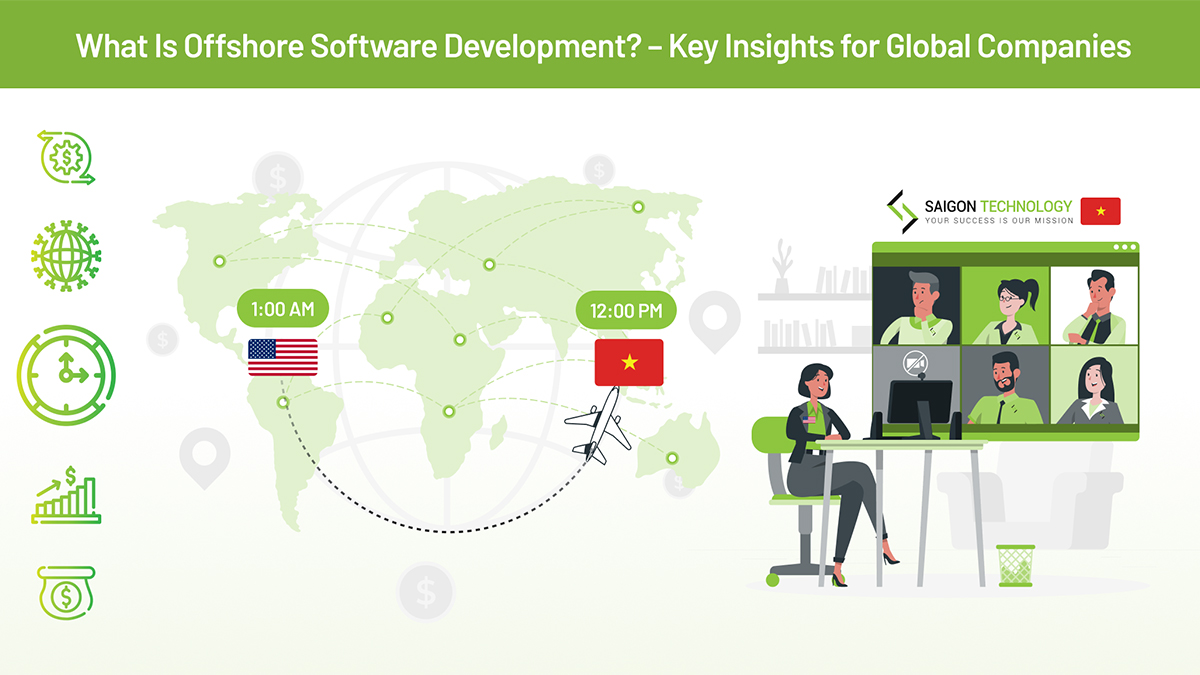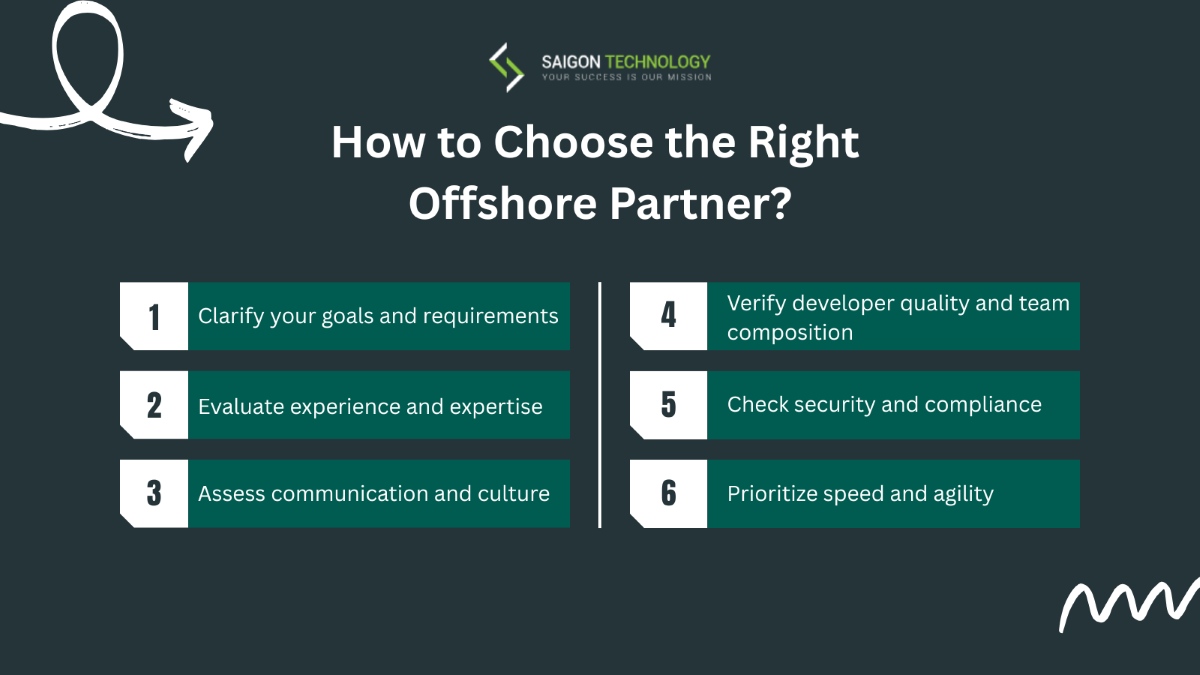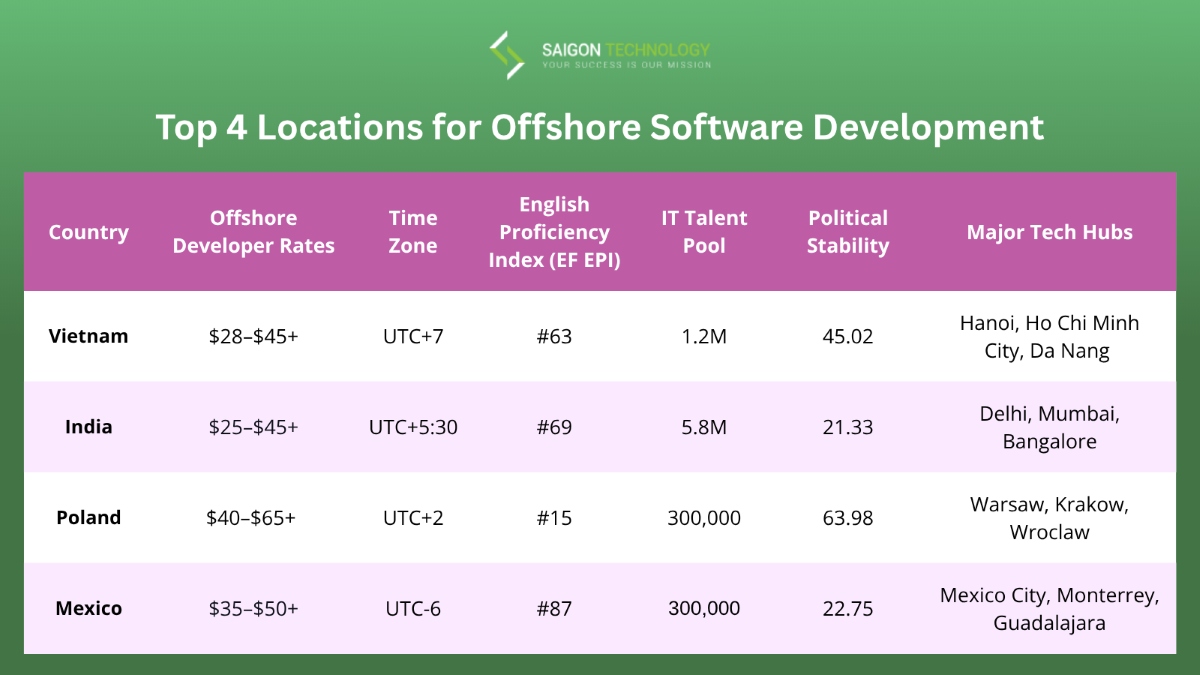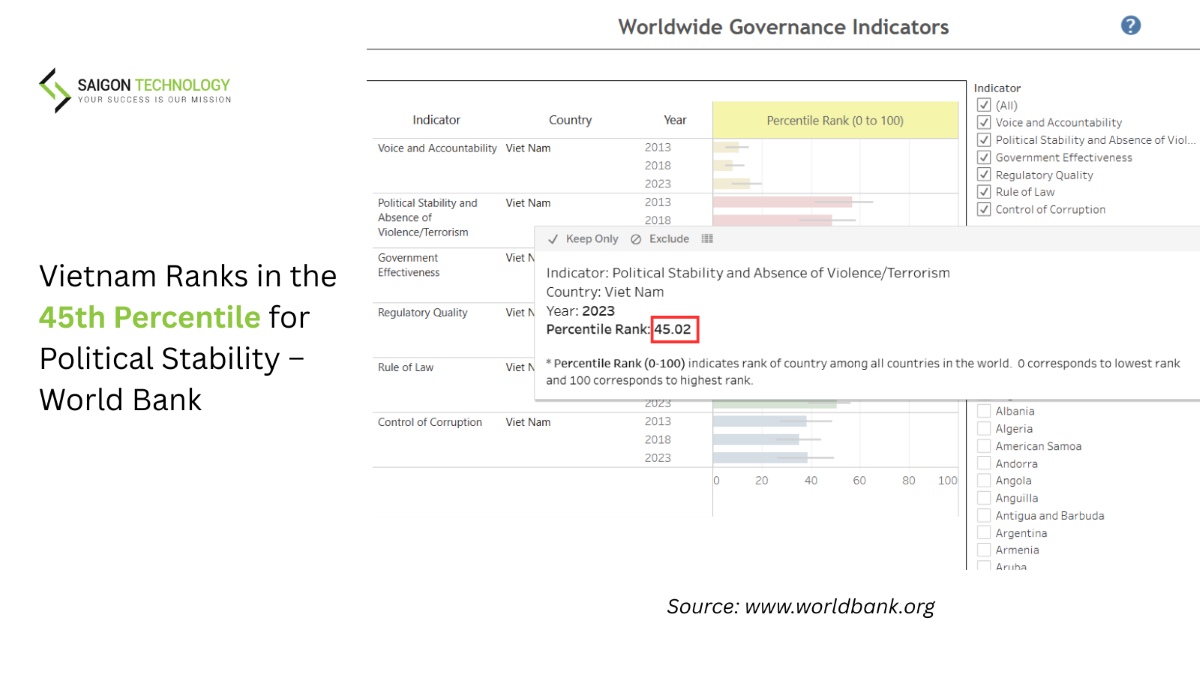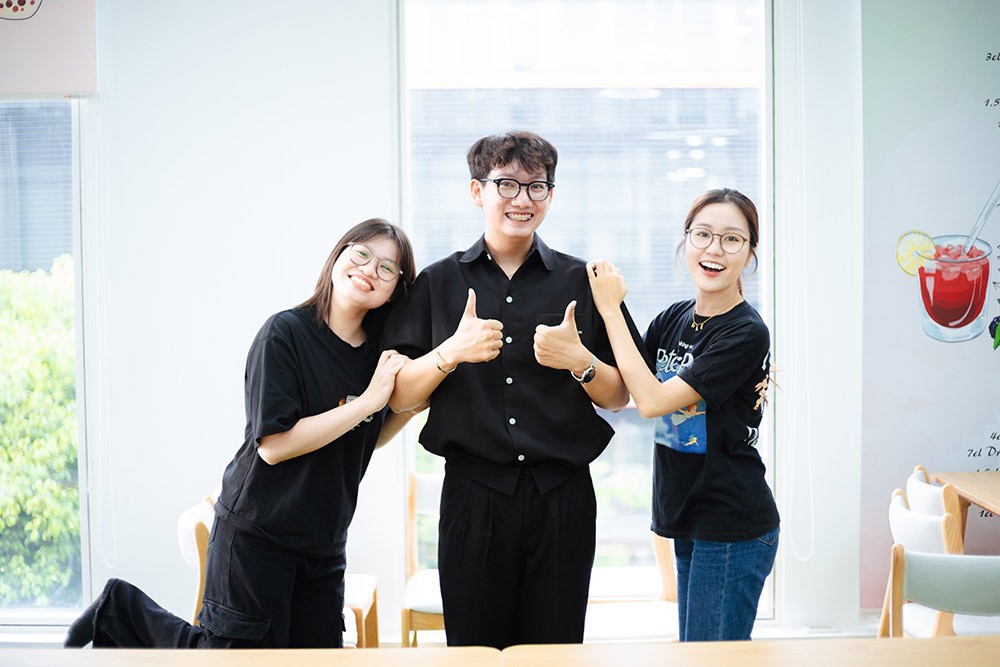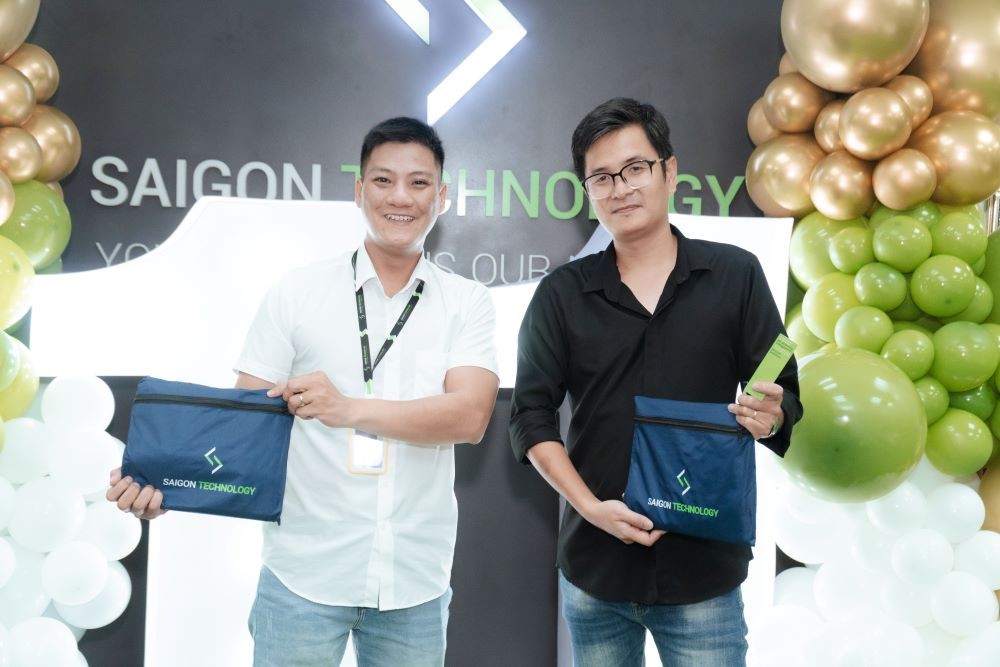Offshore software development combines what businesses need for their growth. Do you want to speed up your product launch or grow your team with specialized talent? Is cost-effectiveness your top priority? Offshore development works as a proven strategy for businesses of all sizes and from many industries. This solution allows you to bridge talent gaps, accelerate time-to-market, and ensure scalability. The cost is lower without sacrificing quality.
In simple terms, offshore software development allows you to delegate development tasks. The offshore teams have an extensive skill set. They help you handle MVPs, proof-of-concepts, and full-scale product delivery. AI integration and legacy modernization are other popular services. This way, you don’t have to manage every detail of an IT project because the experts are in charge.
Saigon Technology has built over 85 offshore tech teams. With over 13 years of experience, we gather practical insights here to help you understand this concept and its benefits. You can also explore the best places for offshore development and choose the right partner.
A Comprehensive Look at the Offshore Industry
In 2024, the global offshore software development market was about $156 billion. By 2025, this figure may reach $178.3 billion, representing a ~14.3 % year-over-year growth rate. From 2025 to 2029, the offshore development market can expand at a CAGR of ~14.4%. So by the end of this period, its value may reach nearly $305 billion.
This impressive growth comes from the talent shortage in local markets such as the US, Australia, and Europe. The rise of new technologies and the high costs of hiring and infrastructure also contribute to its spread. Plus, the demand continues to grow thanks to digital transformation and wide cloud adoption. The need for scalable, cost-efficient solutions plays a vital role, too.
What Is Offshore Software Development?
Offshore software development means you assign part or all of your project to a tech team in another country within a different time zone. Traditional outsourcing is mainly about saving money. Meanwhile, offshore development acts as a strategic approach. More especially, it allows you to achieve cost-efficiency and access to global talent. You can also accelerate time-to-market and scale your development team easily.
You may set up a dedicated ODC in regions rich with talent pools. The most popular offshore destinations are India, Central and Eastern Europe, and Southeast Asia. Offshore development teams in those regions collaborate closely with your in-house staff. These experts have niche skills and offer low developer hourly rates. By partnering with offshore teams, they can tap into a large pool of experienced developers. The low rate is another big plus.
Industry leaders highlight this dual benefit. According to Forbes,
Offshoring and outsourcing have transcended their initial role as a cost-saving measure. Today, it’s a strategic alliance between businesses and technology partners worldwide.
Clients can go far beyond simple staffing. Some providers use the Build-Operate-Transfer (BOT) delivery method. In this manner, they set up and manage a tech team until the client is ready to take over. Others focus on advanced services like automated testing and AI-based development. Your partner can even update legacy systems. Offshore teams then become an integral part of long-term growth and innovation.
2025 Outsourcing Country Comparison – CEO Guide by Thanh Pham
Check cost structures, talent depth, time zone fit, and risks associated across Vietnam (VN), India (IN), the Philippines (PH), and Poland (PL). You can then choose the best choice for your project.
What are the Differences Between Onshore, Nearshore, Hybrid and Offshore Software Development?
Outsourcing is a smart business strategy. Companies can scale quickly and cut costs. They have instant access to specialized talent as well. Yet, not all outsourcing models are the same. There are differences between onshore, nearshore, hybrid, and offshore software development. Check this section to learn their unique pros, cons, and use cases. Each factor affects cost, control, and collaboration efficiency.
| Onshore | Nearshore | Hybrid | Offshore | |
| Location | Same country | Neighboring country/region | Mix of onshore + nearshore + offshore | Distant region (e.g., Asia, Eastern Europe) |
| Time Zone Alignment | Full (same time zone) | Partial (similar zones) | Flexible across regions | Low – requires overlapping hours |
| Communication | Seamless, same culture | Moderate cultural overlap | Varies, requires strong processes | Requires structured workflows, clear tools |
| Cost | Highest | Medium | Balanced (cost savings + local control) | Lowest (best for long-term delivery) |
| Talent Pool | Limited, local | Regional pool (broader than onshore) | Global access (mix of local & global talent) | Largest, diverse pool worldwide |
| Control & Visibility | High (direct oversight) | Moderate | High (strategic retained onshore) | Medium (needs governance structure) |
| Legal/Security | Easiest (same laws, strict compliance) | Moderate differences | Mixed (local compliance + offshore flexibility) | More complex (data laws, IP protection) |
| Scalability | Limited (local constraints, slower hiring) | Moderate (faster than onshore) | High (scalable, multi-region delivery) | Highest (quick scale-up/down globally) |
| 24/7 Development | Limited (unless shift-based) | Possible (time overlap) | Achievable with multi-region teams | Highly possible (leveraging time zone gaps) |
| Best Fit For | Regulated industries, short-term, compliance-heavy projects | Teams needing cultural alignment + time overlap | Scalable long-term product development, continuous delivery | Large-scale, cost-sensitive, long-term builds (AI/ML, SaaS, cloud) |
| Example Use Cases | Local enterprise apps, MVP pilots | Regional eCommerce platforms, support apps | Continuous delivery, agile multi-location dev | Core systems, cloud migration, complex DevOps |
Onshore Software Development
Onshore outsourcing means hiring a development team in the same country as your business. For example, a US company works with a partner in New York.
Pros:
- Simplified communication thanks to shared language, culture, and time zone. Collaboration becomes smoother then.
- Easier project management with face-to-face meetings and direct oversight.
- Regulatory compliance since local teams understand regulations.
Cons:
- Higher labor costs compared to global options.
- Limited talent pool, making it hard to find specialized skills.
Nearshore Software Development
Nearshore outsourcing is when you hire a software team in a neighboring or nearby region with a similar time zone. US companies often partner with tech teams in Latin America. Western European businesses can work with developers in Eastern Europe.
Pros:
- An overlapping time zone provides smoother real-time communication than in offshore software development.
- Competitive average hourly rates thanks to lower costs than onshore options.
- Similar business practices, values, and communication styles.
Cons:
- Geographic limits due to the smaller number of qualified providers than in global offshore markets.
- Not the best option for cost savings.
Hybrid Software Development
The hybrid model combines onshore, nearshore, and offshore development locations into one approach. Typically, product ownership and business analysis stay onshore. Meanwhile, nearshore or offshore development teams handle technical work. These experts ensure smooth progress for coding, QA, and DevOps.
Pros:
- Balanced model. Onshore presence keeps control and quality assurance. Offshore teams help gain cost reduction.
- A high level of scalability and flexibility.
- Around-the-clock delivery as multiple teams work across time zones.
Cons:
- Complex coordination is required because it involves clear communication across tech teams.
- Extra resource allocation and more overhead.
Top Benefits of Offshore Software Development for Global Companies
Offshore development is a strategic option for US companies facing high labor costs and a limited local talent pool. Working with dedicated global teams helps them reduce expenses. Their experience and expertise allow you to deliver faster and remain competitive.
1. Cost-Effective Solutions
The biggest advantage of offshore software development is cost savings. An offshore destination usually charges you less than those in the US. The most popular options are Eastern Europe, India, and Southeast Asia. The salary rates of a mid-level software engineer in the US are around $133,080 per year. Meanwhile, the rate in VN remains about $45,800 on average.
The cost of offshore development isn’t just about developer salaries. Offshoring reduces costs for recruitment, benefits, infrastructure, and compliance. This way, you can free up a budget for innovation, marketing, and customer growth. Startups stretch resources more easily while still accessing strong engineering talent.
2. Access to a Global Talent Pool
Offshore software development allows Western companies to tap into a global talent pool. They can access specialized skills that are hard to find locally. The US Bureau of Labor Statistics projects about 129,200 openings each year. The most recruited positions include developer roles, business analysts, and testers.
In countries like VN, the government prioritizes technical education. This country produces 50,000–57,000 IT graduates annually and over 530,000 engineers worldwide. With nearly 27–29% of students in STEM fields, this workforce is well-trained. You can find talent in many areas like AI, machine learning, cybersecurity, and cloud engineering.
Through offshore software programming, US companies can build tech teams. They hire offshore developers, UI/UX designers, QA engineers, and DevOps specialists for their needs.
3. Faster Time to Market
Recruiting locally can take months. The IT hiring process takes about 50% longer than other roles. This process slows down your project and stretches internal resources.
On the other hand, offshore software development can speed things up. An offshore partner shares qualified CVs in just a few days. Your vendor helps you set up interviews within a week. You can onboard offshore developers almost immediately. The result is faster prototyping and quicker feature launches. You can enjoy a shorter time to market in the end.
4. Scalability and Flexibility
Business needs often change fast. But offshore development helps you adapt. You have many engagement models to choose from. Your vendor assists you in growing a software development team from five to 20 engineers. You can even scale back after a launch. This flexibility allows you to adjust without the overhead of permanent hires.
Moreover, tech teams can scale in weeks instead of months. You have the right expertise when demand shifts. It’s an excellent solution for projects with seasonal spikes. You can handle fluctuating workloads and fast-growing user bases then.
5. Reduced Development Risks
When offshore software outsourcing, your vendor often builds a dedicated team. You now have project managers, QA specialists, and DevOps engineers committed to your goals. This delivery model helps maintain code quality. You can minimize bugs and reduce the risks of costly rework.
Your partner follows a clear process. Offshore teams use Agile methodologies and automated testing to deliver consistency and predictability. That’s what you need for regulated and competitive markets.
6. Ability to Focus on Core Business
Your offshore partner gives you the freedom that you may overlook. The vendor handles recruitment and payroll tasks. They are in charge of administration and day-to-day project management as well. So, you will spend more time focusing on core business activities. There will be more resources for strategy, growth, and customer engagement.
Moreover, you can allocate more resources to sales, product vision, and brand development. Meanwhile, your offshore team ensures technology delivery runs smoothly.
Major Challenges of Offshore Software Development Projects
Offshore software development offers tons of benefits. However, you should still plan for the challenges as follows.
1. Time Zone Differences
One of the major challenges in offshore software development is time zone differences. A US company can hire offshore developers in Asia or Eastern Europe. The tech teams may face delays when dealing with urgent approvals and feedback outside of overlapping hours. This issue slows communication. As a result, you may push back delivery timelines.
How to address it:
- Set up time zone alignment for overlapping working hours and real-time collaboration.
- Use modern tools like Jira, Trello, and Slack for transparent task tracking.
- Hold weekly or daily stand-ups to keep progress on track.
2. Language and Cultural Barriers
Many leading offshore development hubs do not use English as their first language. The lack of English language proficiency leads to miscommunication when the two teams interact. As a result, your project suffers from misunderstandings and mismatched expectations. You face cultural differences, too, like holiday schedules or work styles. Your workflows and work quality may endure.
How to address it:
- Evaluate English skills during hiring.
- Provide cultural awareness training for both in-house and offshore software development teams.
- Rely on clear documentation and frequent video calls to keep everyone aligned.
3. Talent Scarcity in Key Specialties
In offshore software development, offshore regions offer a large talent pool. Yet, there can be shortages of mid and senior-level experts. Things get harder when you work in fields like AI, cybersecurity, and cloud infrastructure. Competition for these roles can slow recruitment and raise costs. Thus, it’s hard to secure the right offshore programmer.
How to address it:
- Work with vendors that maintain pre-screened talent databases.
- Consider hybrid models. In this manner, specialized roles can be onshore or nearshore.
- Plan workforce needs early to secure scarce skills before demand rises.
4. Security and Legal Risks
Another concern in offshore development is handling sensitive assets. Your project has source code, system architecture, or customer information. Security challenges include risks of data leakage, unauthorized access, or IP disputes. So be careful when working across jurisdictions with different legal protections.
How to address it:
- Sign a strong NDA and clearly define intellectual property rights in contracts.
- Follow international compliance standards like ISO 27001, GDPR, and HIPAA.
- Use encrypted data storage and secure transmission methods.
5. Quality Assurance Challenges
Geographic distance can make offshore software development harder. You have to maintain coding standards and quality benchmarks. In some cases, you may face pressure to reduce wages or improve working conditions. Then, your vendor cuts corners. The results can be rework, delays, or weaker product quality.
How to address it:
- Set clear coding standards and testing protocols from the start.
- Use automated QA and continuous integration tools.
- Run regular audits and code reviews to ensure ongoing quality.
Best Practices for Offshore Development
Offshore software development delivers major benefits. But the results are not the same for everyone. You should first choose the right offshore development partner, then focus on managing the offshore team. It’s the only way to long-term success.
How to Choose the Right Offshore Partner
The vendor determines the result of your project. A good partner isn’t just a coding provider. They understand your goals, align with your vision, and integrate smoothly with your internal team. Here’s how to choose your perfect companion!
1. Clarify your goals and requirements
First, define your product vision, budget, and delivery time. An offshore software development project has well-defined requirements, both functional and non-functional. You can use the SMART framework (Specific, Measurable, Achievable, Relevant, Timely), too. The key is to ensure your offshore partner has a clear reference point.
2. Evaluate experience and expertise
Review case studies, portfolio, and client testimonials. You can check ratings on third-party websites like Clutch, GoodFirms, G2, or DesignRush. As you assess offshore software development firms, focus on those with proven success in your industry. They may be excellent in your chosen technologies, like AI, cloud infrastructure, or IoT, to adapt to your technical requirements. An experienced firm often follows Agile and Scrum methodologies to ensure smooth progress.
It would be best to choose a company with experience working with international organizations. They offer multiple pricing and cooperation models. You can choose from a dedicated team, ODC, staff augmentation, project-based cooperation, or BOT model.
3. Assess communication and culture
Ensure English proficiency and clear communication. You can ask your potential partners how they manage onboarding, workshops, and ongoing teamwork. Check their collaboration tools to support transparency, too. Also, consider cultural compatibility. Shared work styles can make collaboration smoother.
4. Verify developer quality and team composition
Successful offshore setups involve more than just offshore developers. You need UI/UX designers, a strong QA team, DevOps, and business analysts to meet your technical requirements.
So, ensure your vendor delivers a cross-functional team that scales with your project. Your offshore development team should maintain high offshore developer quality as well.
5. Check security and compliance
You need a secure system architecture for your software. Your offshore partner should demonstrate strong cybersecurity & compliance. So, check if they follow strict security practices.
Besides, you should sign NDAs and define IP ownership in contracts. Ensure regulation compatibility with standards like ISO 27001, GDPR, and HIPAA. It’s also important to review their encryption procedures, access control, and data protection measures.
6. Prioritize speed and agility
The right offshore development partner can quickly assemble tech teams and adapt to changes. Ask about their hiring timelines and MVP delivery speed. They should be flexible in scaling resources, too. Plus, check which project management methodologies they follow. Assess if they offer models like the BOT delivery method to enhance security.
How to Effectively Manage an Offshore Team
So you’ve got a partner. Effective management is what you need now to unlock their full potential.
1. Share your mission and vision
Your offshore team doesn’t just act as an execution unit. Transparent workflows are essential for offshore software development. During onboarding, you need to share your company’s goals, values, and product roadmap. So, they feel invested in long-term success.
2. Build cultural alignment
In offshore software development, you need to recognize and appreciate contributions openly. Bridge cultural differences with team-building activities. Occasional site visits are equally important. A “one team” culture across US and offshore offices also helps build trust and long-term collaboration.
3. Establish strong communication
Clear communication is key to avoiding costly misunderstandings. You can use multiple communication channels. For example, emails are ideal for formal updates. Instant messaging tools like Slack and Teams allow for quick chats. Project management platforms like Jira, Asana, and Trello work well for task tracking. Hold daily stand-up meetings, too. Sprint reviews and retrospectives also keep everyone aligned and projects on track.
4. Apply disciplined project management
Offshore agile development methods like Scrum bring flexibility and faster delivery. Clear project management processes are essential for offshore development. You need to define roles, responsibilities, and decision-making authority upfront. A project manager is in charge of overseeing execution. Besides, set milestones and KPIs to measure performance and track progress updates. Project management tools can help you with those tasks.
5. Ensure quality assurance from day one
Define coding standards and run peer code reviews from the start. Also, integrate automated testing tools like Postman, JMeter, and Appium. You should ensure QA engineers are part of the offshore team throughout development. During the project, track milestones and deliverables closely to guarantee consistent quality.
Top 4 Locations for Offshore Software Development
US, EU, and Australian companies desire to balance a talent pool size and English proficiency. Cost, talent quality, and political stability are other important criteria. Here are four standout destinations based on those factors:
1 . Vietnam – Fast-Growing Tech Hub
- Talent Pool: 1.2M developers, growing rapidly.
- Cost Advantage: $28–$45+ per hour.
- Strengths: Improving English proficiency (#63 rank) and competitive average hourly rates. The talent pools are wide. Strong STEM system and good talent quality (#23 HackerRank) ensure a high-quality workforce. The country has increasing government support, favorable tax conditions, and competitive exchange rates.
- Considerations: Political stability is moderate (45.02 percentile), though improving.
- Best For: Startups and enterprises that need skilled engineers. They can access offshore software development experts in AI, fintech, and mobile development. The best thing is that you enjoy high-quality products at affordable rates.
2. India – Largest Talent Pool at Competitive Rates
- Talent Pool: 5.8M developers (largest globally).
- Cost Advantage: $25–$45+ per hour.
- Strengths: Talent availability, broad technology coverage, and experience with U.S. clients. The low cost of living leads to significant cost reduction when running offshore projects.
- Considerations: Regional gaps in English proficiency (#69 rank); Lower political stability (21.33 percentile).
- Best For: Large-scale offshore software development projects. In such cases, you need quick hiring across multiple technologies.
3. Poland – High Talent Quality and EU Standards
- Talent Pool: 300K developers (one of the strongest in Eastern Europe)
- Cost Advantage: High cost at $40–$65+ per hour (higher but justified).
- Strengths: Strong technical education systems. Excellent English proficiency (#15 rank) and top-tier talent (#3 HackerRank). Compliance with EU data protection standards is another plus.
- Considerations: Smaller offshore developer pool compared to India.
- Best For: Complex offshore development projects that demand strong governance. Clients can also ensure compliance and advanced engineering.
4. Mexico – Nearshore Advantage for U.S.
- Talent Pool: 300K developers
- Cost Advantage: $35–$50+ per hour.
- Strengths: Nearshore location (UTC-6 time zone) with Latin America. Easier cultural alignment and growing tech ecosystem
- Considerations: Lower English proficiency (#87 rank). Weaker political stability (22.75 percentile).
- Best For: Companies that need real-time collaboration. They will also ensure frequent communication and short travel distances with the vendor.
Top Offshore Software Development Trends in 2025
Offshore software development is booming. Here are the trends that shape this industry in 2025.
1. Enterprise Stacks Stay Dominant: Java, Python, .NET (+TypeScript/Node)
In offshore software development, enterprise stacks lead demand. JavaScript/TypeScript, Python, C#/.NET, and Java remain the most widely used technologies. Python and TypeScript also grow fast.
Why it matters: Vendors should deliver with Spring/Spring Boot (Java), .NET/.NET Core (C#), Python (FastAPI/Django), and Node/TypeScript. API, messaging, and database expertise are essential, too.
2. Cloud-Native by Default: Kubernetes + Multi-Cloud
Cloud computing is now popular in offshore software development. According to the 2023 CNCF survey, 66% of end-user orgs report running Kubernetes in production. Another 18% are evaluating. Multi-cloud is growing as well. Many businesses use two or more cloud providers. Cloud-native architecture by default is expected.
What to ask vendors for: Vendors should show Kubernetes references and IaC (Terraform) patterns. Clients need strong knowledge of cloud-native technologies across AWS/Azure/GCP.
3. Platform Engineering & DevSecOps Maturity
According to Gartner, platform engineering and AI-augmented development are among its key tech trends in software engineering. Puppet’s 2024 State of DevOps also highlights how platform teams improve speed, efficiency, and security. Offshore development takes the chance.
Buyer takeaway: DevOps-advanced teams deliver golden paths, paved roads, and self-service CI/CD. Your partner should prove results with DORA-style outcomes.
4. AI Woven into the SDLC (not just the product)
You can easily find a software offshore development vendor using AI. McKinsey reports 65–78% adoption depending on year and scope. DevSecOps surveys show that tech teams use AI-powered tools and machine learning to boost code quality. Process automation also improves productivity.
In practice: Your vendor uses AI-assisted code reviews and defect detection tools. You can take advantage of planning estimations and automatic testing. All are backed by governance measures, such as model choice and auditability.
5. Business Intelligence and Data Engineering Muscle
AI adoption expands. Offshore partners are now building strong data engineering and analytics teams. These technologies empower modern business intelligence systems. MLOps pipelines help deliver real-time insights and model pipelines alongside apps. This trend mirrors the broader enterprise shift to data-driven operations.
Ask for: You should look for vendors with experience in streaming platforms like Kafka and lakehouse solutions. Pay attention to feature stores and secure ML lifecycle management as well.
6. Security And Compliance Shift Left
Cybersecurity and data protection are becoming key to offshore software programming. Research in 2024 shows that cybersecurity protocols are one of the top areas of investment for modern DevSecOps teams. Businesses now use software supply-chain security and zero-trust practices. They adhere to standards like SOC 2, ISO 27001, GDPR, and HIPAA.
What good looks like: Effective practices include SBOMs and signed artifacts. Good security also requires SAST/DAST in CI and dependency scanning. Secrets management and clear IP or contract terms are equally important.
Case Studies: Success Stories in Offshore Software Development
Case Study Name: Personal Loan Platform
Industry: Finance
Challenges: The client needed to scale their senior engineering team to 20 people in just three months. Another request was about modernizing an outdated system. The main challenges were fast hiring and dealing with legacy technology. We also had to manage remote teams across different time zones.
Solutions: We accelerated recruitment and onboarding to quickly assemble a strong offshore development team. Structured knowledge sharing helped engineers adapt fast. Shared working hours improved real-time collaboration across global teams.
Results: Within three months, the client had a complete tech team of 20 senior engineers. Our team updated the platform with modern infrastructure. New features included a funnel builder, experimentation tools, and advanced fraud detection. We supported the Transfer-Based Lending (TBL) model, too. These changes enhanced user experience and reduced time-to-market.
Why choose Saigon Technology for Offshore Software Development?
Saigon Technology is a trusted offshore development partner. By partnering with us, you can access:
- Scalable and cost-efficient solutions powered by top engineers.
- Instant reach since we have software centers in Ho Chi Minh City and Da Nang to serve global companies.
- End-to-end software development solutions with accelerated delivery, optimized costs, and enterprise-grade quality.
- 13+ years of experience and 350+ qualified engineers with strong English proficiency. Our team has served clients from the US, Australia, the UK, Germany, and Singapore.
- ISO 27001 and 9001 certifications that show our trustworthiness.
- Experience in delivering 85+ dedicated teams and transferring 44+ offshore developers through the BOT model.
- Extensive expertise in backend, frontend, cloud, app development, and DevOps technologies. You also find experts in advanced tools like AI, blockchain, and IoT.
Your Next Step in Offshore Software Development
Offshore software development is no longer just a cost-saving method. It has become a global trend. Companies can use it to access specialized talent and speed up time-to-market. Choosing the right offshore partner is critical for long-term growth. Saigon Technology stands out as an excellent choice. We combine scalability, security, and cost effectiveness. Ready to explore how offshore development can optimize your operations? Contact Saigon Technology today and start your journey to success!
FAQs
1. Does Cheaper Offshore Development Equal Lower Quality?
No. Offshore development is often affordable because of:
- Lower labor costs in countries such as VN, IN, and Eastern Europe compared to the US.
- Favorable exchange rates and tax policies.
- Lower overhead expenses for office space, benefits, and infrastructure.
These factors create a better cost-to-quality ratio. Many offshore engineers are highly trained. They have strong STEM backgrounds and experience serving global clients. Yet, risks can still arise if:
- You choose vendors just based on the low price.
- Your software development team lacks experience in your industry and tech stack.
- There are no effective project management, communication, or quality assurance practices.
2. How to Bridge Language and Cultural Barriers When You Hire Offshore Developers?
You may face language and cultural differences. Some practices to ensure clear communication for your offshore software development project are:
- Prioritize English proficiency: Check the offshore developers’ language skills during hiring. Ensure project managers and key contacts communicate smoothly.
- Create clear communication routines: Use shared tools like Slack, Teams, and Jira. Regular standups and status calls also help reduce misunderstandings.
- Document everything: Ensure you have written requirements, user stories, and acceptance criteria. These documents help bridge gaps that spoken communication may miss.
- Build cultural awareness: Offer briefings and workshops for both your external and internal teams. The topics should be about cultural norms, holiday schedules, and work styles.
- Promote inclusion: Treat your offshore team as part of your company. You should share company goals, celebrate milestones, and encourage open feedback.
3. How Do You Collaborate with Offshore Teams in Different Time Zones?
Time zone gaps are a major challenge in offshore development. Yet, you can handle them with the right methods. For example:
- Create overlapping hours: Arrange at least 2-4 hours of shared time each day for real-time collaboration.
- Use async-first tools: Platforms like Jira, Trello, Slack, and Confluence help keep work moving without delays.
- Schedule regular meetings: Weekly sprint reviews and daily or bi-weekly standups maintain alignment.
- Rotate meeting times: Share the inconvenience between the US and offshore teams.
- Document clearly: Write down requirements and meeting notes carefully. Handoffs also help you avoid reliance on live discussions.
4. How Do You Ensure Security in Offshore Software Development?
Offshore software development can be very secure when managed correctly. The biggest risks relate to data protection, IP, and compliance with US laws. Best practices for ensuring security are:
- Legal safeguards: Sign NDAs and clearly define IP ownership in contracts.
- Industry certifications: Choose vendors that have ISO 27001, SOC 2, GDPR, or HIPAA certifications. Your industry may also require compliance with other standards.
- Technical controls: Follow secure coding standards, encrypted data transfer, and strict access management.
- Continuous monitoring: Ensure vendors conduct audits, penetration tests, and vulnerability checks regularly.
- Vendor reputation: Work with providers with experience in the US markets and regulated industries.
5. What Are the Warning Signs When Evaluating Offshore Vendors?
The key to offshore software development success is in your partner. Watch out for these red flags to avoid risks related to security, time, and money:
- Vague or unrealistic pricing: Very low rates without clear details can hide extra costs or suggest poor quality.
- Lack of transparency: A vendor should provide case studies, references, or sample work. If not, their experience may not match their claims.
- Weak communication: Be careful with delayed replies. Poor English skills and missing project updates are also signs of professionalism.
- Missing security or compliance standards: Absence of certifications like ISO 27001, SOC 2, or GDPR is a red flag for sensitive projects.
- Frequent staff turnover: Constant changes in team members may disrupt project flow and continuity.
- Overpromising capabilities: Vendors may claim expertise in every technology. Yet, they lack proof in your specific stack.
- Poor project management setup: You need structured methodologies (Agile or Scrum) to run your project. So ensure your partner uses proper tools.

